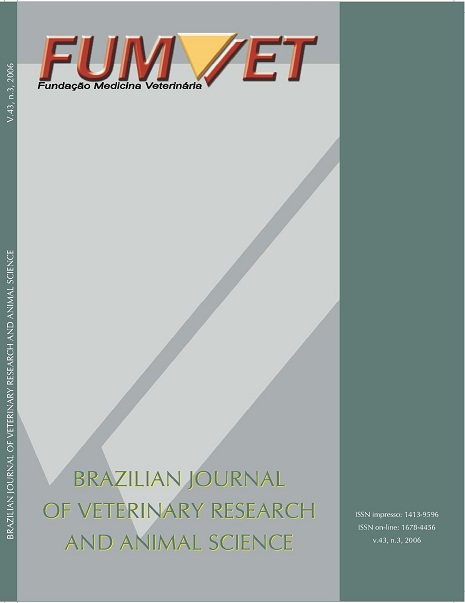Intestinal Protozoa in apprehended New World nonhuman primates
DOI:
https://doi.org/10.11606/issn.1678-4456.bjvras.2006.26483Keywords:
Marmosets, Brown howler monkeys, Cryptosporidium, Blastocystis hominis, Nonhuman primatesAbstract
The objective of this study was to identify intestinal protozoa in fecal samples of illegally commercialized New World nonhuman primates apprehended by governmental authorities and sent to a Wildlife Screening Center in the municipality of Seropédica, State of Rio de Janeiro, under the administration of Instituto Brasileiro de Meio Ambiente e Recursos Naturais. Feces from marmosets (crossbreeding among Callithrix jacchus and C. penicillata) and brown howler monkeys (Alouatta fusca) were collected and submitted to Richtie's formaldehyde-ether sedimentation technique. Smears were made with the sediment and submitted to safranin-methylene blue and Wheatley's modified trichrome stainings. Phenol-auramine staining was used in order to compare positive smears for Cryptosporidium oocysts stained with safranin-methylene blue technique. Three (100%) fecal samples of brown howler monkeys and eight of common marmosets (88.9%) were positive for Cryptosporidium oocysts. Blastocystis hominis-like forms were observed in all samples of brown howler monkeys and in 66.7% (6/9) of marmosets. New World nonhuman primates Callithrix crossbreed species and A. fusca can harbor forms similarly identified as potential zoonotic organisms. The strict contact between monkeys and humans can represent risks for both by mutual transmission of pathogens. It is unknown if monkey species studied in the present work are either infected with these parasites in natural environment or acquire it when submitted to human contact. Stressing is also a factor that deserves attention on animals submitted to capture, apprehension and transport to Wildlife Screening Centers.Downloads
Download data is not yet available.
Downloads
Published
2006-06-01
Issue
Section
UNDEFINIED
License
The journal content is authorized under the Creative Commons BY-NC-SA license (summary of the license: https://
How to Cite
1.
Carvalho Filho PR de, Cardozo SV, Ribeiro CT, Medeiros SM de, Lopes CWG. Intestinal Protozoa in apprehended New World nonhuman primates. Braz. J. Vet. Res. Anim. Sci. [Internet]. 2006 Jun. 1 [cited 2024 Apr. 19];43(3):354-61. Available from: https://revistas.usp.br/bjvras/article/view/26483





